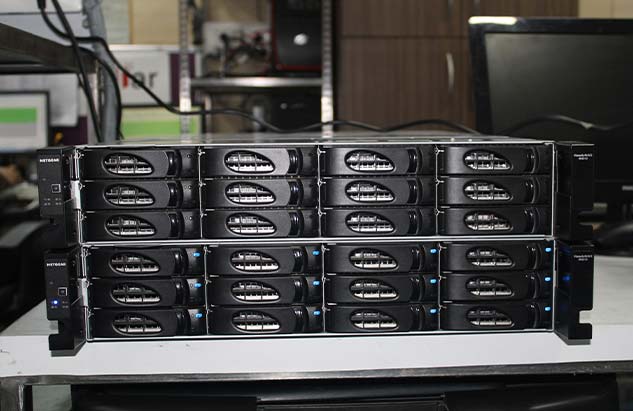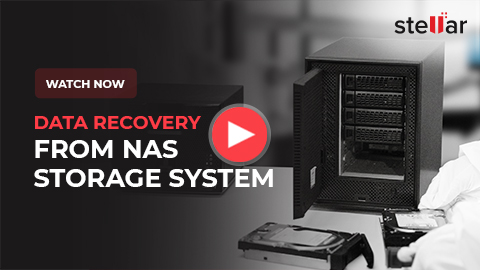Chapter 5 of 5 | Published On
Chances are you believe that your NAS system will never malfunction. Also, chances are you believe that because you’re using your NAS in a RAID configuration, the redundancy will mean you’ll never need NAS data recovery. But NAS failures are more common than you believe. When your NAS fails, the last thing you want is to aggravate the data loss. Instead, know and follow the best practices of handling a NAS failure.
In the last chapter, we learned about:
- The key causes of data loss in NAS,
- Why users must not experiment with NAS configurations, and
- Best practices for avoiding data loss
In this chapter, we'll learn about:
The limitations of NAS
- What you shouldn’t do when your NAS fails?
- Why rebuilding your NAS isn’t an experiment worth trying?
- What you should do when your NAS fails?
An Introduction to NAS Failures
Every week, our data recovery experts at Stellar receive anxious enquiries from NAS users, about NAS failures. They report NAS failures for all kinds of reasons: overvoltage, power disruption, erroneous admin setting changes, physical damage to the hard drives configured in the NAS box, inadvertent deletion of VM volumes, unintended formatting of the volume, and whatnot.
In some of these cases, users panic in response to the NAS failure. Then, they commit some mistakes, which aggravate the damage to the NAS and the RAID setup. Ultimately, this aggravates the data loss and complicates the data recovery.

When Your NAS Fails, Don’t Make These Mistakes
So, here’s what you should NOT do if your NAS fails.
1. Do Not Attempt to Rebuild Your NAS When It Stops Working
Most NAS boxes are technically equipped for RAID recovery. In some NAS admin software, the auto-rebuild option is switched on (by default).
Let's understand why manual (or even automatic) RAID rebuilding may hamper your data recovery chances. Let's imagine a situation where:
- You've set up your NAS in the RAID configuration built for tolerating at least one drive failure.
- One of the hard disks in the NAS malfunctions.
Now, even if your RAID setup includes 4 hard disks of 4 TB each, the rebuilding will take several days.
This duration is extremely critical for your NAS.
- That's because you can't be sure what caused the NAS to stop working. The same factor could cause other hard drives to malfunction, while the RAID is trying to rebuild itself.
- The hard drives can get overheated during the rebuilding. If the ventilation at your premises isn’t great, the drive can’t dissipate the excess heat, and is soon damaged.

Every week, we receive countless queries for NAS data recovery at Stellar Data Recovery. In dozens of these cases, diagnostics efforts reveal scenarios wherein:
- RAID rebuilding stops at 30% to 50%.
- RAID rebuilding creates a new file structure, rendering massive original data inaccessible.
- RAID rebuilding creates a new file structure or a new index.
- RAID rebuilding shuffles the sectors of the hard drives.
- Voltage fluctuations and power disruptions during rebuilding cause the entire NAS data to be lost.
Because we can't recreate the exact replica of all system variables at the time of the original NAS failure, it's difficult to diagnose the cause of the data loss.
The bigger question always is: can we recover data from a failed NAS? And data recovery from NAS is likelier when you don't attempt to rebuild your RAID after the original failure.
Still, why do so many IT administrators make the mistake of rebuilding their failed NAS?
- They panic when they realize their NAS box has failed, and feel compelled to 'do something about it themselves.
- They don't wish to risk disrupting their crucial data-dependent processes.
- They don't want to spend time (7-10 days) engaging with NAS data recovery experts and want an option that promises recovery within the same day.
- They fail to understand the risks of experimentation with RAID configurations.
- They tend to underestimate the complexity of data recovery.
2. Do Not Tamper With The Disk Arrangement
Changing the order of the hard disks in your NAS RAID array could cause the NAS setup to malfunction. This could easily escalate into a NAS-wide data loss. In such a situation, the data loss might be permanent, caused by overwriting.
Why should you not change your hard disk order in your NAS setup?
- When your NAS fails for any reason, it might trigger several backend processes linked to RAID recovery. The RAID recovery process is extremely fragile, and any changes in the system can disrupt it, and perpetrate data loss.
- Removing any hard disks from a failed NAS isn't as simple as disconnecting it. This could easily disrupt the RAID setup and cause the NAS to work in degraded mode.
We've also seen cases where a client was promised a 24-hour recovery by a local vendor. Here’s what happened.
- The vendor didn’t conduct any remote diagnostics session, Instead, they told the client to ship the entire NAS hardware (NAS box, all hard drives, cables) to their lab.
- The client wasn’t given any instruction about the risk of removing hard drives from the NAS.
- Improper removal of hard drives caused further data loss for this client.

We later informed them that it’s not necessary to ship the entire NAS box to a data recovery lab. A professional NAS data recovery service will only tell you to ship the NAS box when they need some information that’s
hard-coded into the NAS box. This isn’t common.
The desire to carry out immediate tweaks in a failed NAS system (such as replacing a failed hard disk, rearranging the order of the hard disks, etc.) can backfire. And in 80% of the cases, it actually backfires and causes permanent data loss.
Here’s what to do instead.
- Resist the temptation to tinker with your NAS setup or the RAID settings if the NAS fails. Be prepared with a business continuity plan.
- Give yourself the time to engage with professional NAS data recovery experts.
NAS Failed. Now What?
Don’t waste a moment. You need a professional data recovery service.
At Stellar, we execute high-precision data recovery for NAS. During our recovery, we only need the damaged hard drive(s).
Our NAS data recovery is highly specialized.
- We recreate the RAID with all its original settings (using our spare NAS boxes, hard drives, cables and connectors, spare hard disk parts)
- We create a clone of the affected hard drives, and conduct all recovery exercises on the clone, and not on the original drive.
- We analyze the original parity bitmap during the data recovery process.
This makes the data recovery risk-free.
At Stellar, we recover data from failed NAS systems day in and day out.
Call us and explain the situation to our recovery expert. We are happy to offer a 30-minutes free consultation over the phone. During this consultation, we can try to determine the likelihood of data recovery, and explain the next steps to you.





